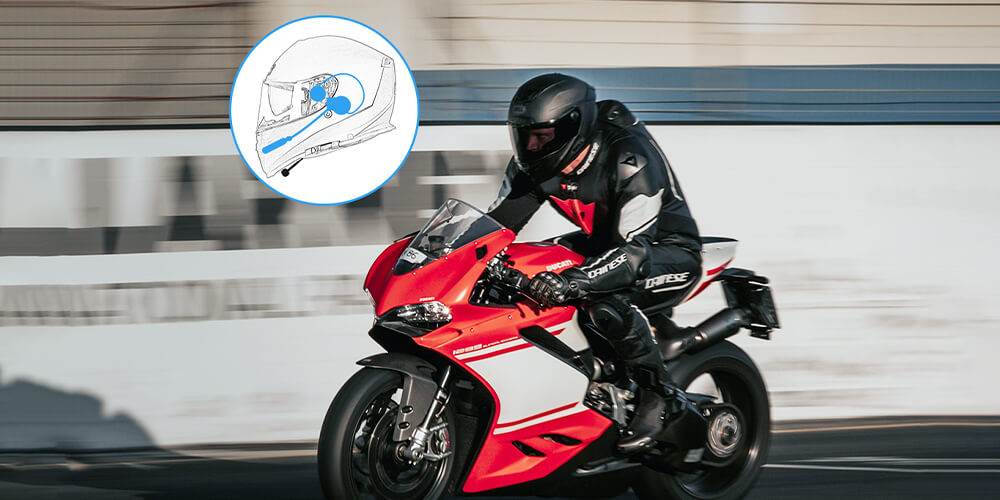What can a helmet to helmet intercom do? You can maintain a steady connection with your passenger or other riders. They are incredibly convenient for lengthy travels and are readily fitted on your helmet. Today we will talk about why you need it and how to choose the best one for your riding.
- Three reasons you need a helmet to helmet intercom
- What is the best helmet to helmet intercom system?
- What other equipment should a motorbike rider have?

Three reasons you need a helmet to helmet intercom
1. It can apply to more than just riding but other exciting activities
This kind of microphone is commonly used by motorcyclists. When you search for "helmet mic" "Bluetooth intercom" "communication for motorcycle riders", the words and results that come up are always linked to motorbike, but in fact, this type of device is not only used for this purpose, helmet to helmet intercom for bikes can be said to be used for all major intense sports such as skiing, climbing, and other activities that involve multiple participants and require communication.
2. It ensures the fun and safety of your on-road experience
It s a practical investment if you enjoy going on rides with your pals and staying in contact the entire time. They come with microphones and headsets. Riders on motorcycles may use the wireless helmet to helmet intercom to make calls, listen to music, or chat with other riders while they are on the road. Having the appropriate equipment isn't the only thing a rider needs. It's crucial to have a motorbike training facility. Even though riding a motorbike can be dangerous, a rider has control over how they reduce their risks.
3. A professional motorcycle team shall have a helmet to helmet intercom system in races and games
If in normal riding, this device can add fun, allowing you to listen to music, make phone calls and chat with friends, then in the race, it is your Bluetooth helmet communication that is extremely essential. You need to know the situation of your teammates in real-time, but also let each other know your situation, to deal with some sudden events, along with a better plan. It also allows you to exchange information and cooperate well in the game.
What is the best helmet to helmet intercom system?
A helmet microphone that includes the next five features below shall be recognized as a good option.
- Compact and lightweight for easy carrying and mounting
- Simple and convenient operation design for versatile functions
- High-quality sound audio with long-distance transmission
- Solid and weatherproof building materials for
Spec. form of four helmet microphones at Moman PhotoGears Store
|
Moman |
H1 |
H2 |
H3 |
H4 |
|
Product Type |
Helmet Intercom |
Helmet Intercom |
Helmet Intercom |
Helmet Earphone |
|
Working Time / Stand by Time |
30h / 500h |
20h / 300h |
30h / 500h |
5h / 30h |
|
Charging Time |
2.5h |
2h |
2h |
1h |
|
Bluetooth Tech |
5.1 |
5.0 |
5.0 |
5.0+EDR |
|
Transmission Distance |
1500m |
800m |
1000m |
30m |
|
Noise-cancelling Tech |
DSP |
DSP/CVC |
DSP/CVC |
DSP |
|
Phone Connection |
√ |
2 at one time |
2 at one time |
2 at one time |
You can see that these four use the latest Bluetooth technology 5.0 or 5.1, and all have a long working time to be able to connect to your phone. Here we will introduce the H1 and H2 best helmet to helmet intercom.
Moman H1 2-rider pack Bluetooth communication intercom

The Moman H1 can carry up to 2 riders over a distance of 500 meters using Bluetooth 5.0. Compared to earlier models, this Bluetooth headset has better speakers with high-quality audio thanks to the DSP smart chip and a more straightforward button arrangement.
Moman H2 motorcycle helmet to helmet intercom with a long run time

As a unique Bluetooth communicator for motorcycle helmets, the Moman H2 is distinguished by outstanding build quality and endurance. This Bluetooth headset can function in conditions of 20°C to 50°C and is waterproof. Couples and close friends will appreciate this headset's ability to link up to 2 riders at a distance of up to 800 meters.
What other equipment should a motorbike rider have?

1. Helmet
More than everything, a helmet should securely and pleasantly fit the rider. A chin bar should fit well on the face, and an open-face helmet should offer sufficient protection for the sides and rear of the head. Before buying a helmet to helmet intercom, you should check whether it is a match to install in your helmet.
2. Wearings & boots
There is always a potential that you won't ever put anything other than the bottoms of your boots in contact with the pavement. Wearing sturdy gear will shield you against road rash, one of the most agonizing conditions a cyclist may encounter. After your mishap, the doctor will need to clean up the wound, which is probably covered in road dirt and anything else you may have slipped through. Without the use of numbing drugs, this is finished with a sturdy nylon brush. When deciding whether to wear shorts on a hot summer day, keep this in mind. Motorcycle-specific apparel may feature padding made of Kevlar, premium
leather, and plastic body armor.
3. Gloves
What normally lands on the ground first when you trip and fall? It’s crucial to have proper hand protection. To avoid abrasion in the event of a fall at high speeds, look for gloves made of strong materials. Some gloves have "sliders" or "palm sliders" that, if you slide down the road, protect your palms while absorbing the force of the fall. Gloves can shield you from any other unexpectedly weird harm to your hands, full finger gloves would have been ideal.







